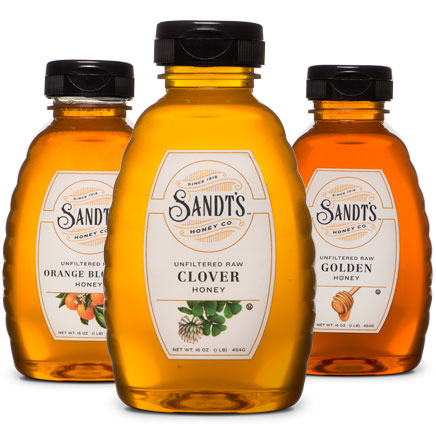
Unfiltered Raw Honey – As The Bees Intended
About Our Products
Aristotle philosophized that honey was a dew distilled from the stars and the rainbow. And, to A.A. Milne’s lovable creation Winnie the Pooh “hunney is the most wonderfulest stuff ever!”

Every bottle of Sandt’s honey is genuine, pure honey. Unlike the majority of honey sitting on store shelves today, we at Sandt’s do not alter our honey. Nor do we add extenders, additives or anything else. We simply provide exceptional “unfiltered raw honey – as the bees intended”.
What is Honey?
By definition honey is a sweet sticky fluid produced by bees from the nectar of flowers. After busily buzzing from blossom to blossom, the honeybee returns to her hive with her harvest. Bees have glands that excrete special wax which they shape into the familiar hexagonal honeycomb cells. After depositing the nectar into these units, the bees ripen it by fanning their wings to evaporate excess moisture and then seal their treasure with additional wax.
What determines Honey's flavor?
The flower from which it comes determines the flavor, aroma, color and to some extent the body of a honey. For example, clover and alfalfa produce a mild, light colored honey; orange blossom is a fragrant, somewhat citrusy honey; buckwheat a dark, pungent honey. Honey also may take its name from a general grouping of flowers, such as wildflower, or from a particular geographical region.
Honey is available in a number of flavors - none of which is "man-made".
The best honeys come from areas with an abundance of good nectar-producing plants. Some sources of excellent clover and alfalfa honeys are the Dakotas and other Midwest states, and Argentina. Orange blossom honey may come from Florida, California or Mexico. Tupelo honey is a specialty of Florida, blueberry of Maine and New Jersey, and buckwheat of New York state and Canada. The supply of each honey varietal can fluctuate for a number of reasons (EG: weather, crop disease, bee colony health, etc.).
Our Honey
At Sandt’s, we pride ourselves on carrying on the tradition of supplying providers and consumers with the best, unfiltered honey money can buy. We strive to exceed standards and educate the public about the benefits of unfiltered honey.
Be sure to visit each of the flavors below to learn more about what makes them unique!

Select products now available on Amazon.
Shop NowFrequently Asked Questions
If your question is not answered here, please get in touch.
Where are your bee hives?
We no longer have our own bees and haven’t since the 1970s. We strictly package honey.
Where do you get your honey?
It comes from beekeepers all over the USA, Canada and even over seas.
Why is your honey ‘cloudy’?
It is because we do not filter our honey. Filtered honey is honey that has been filtered to the extent that all or most of the fine particles, pollen grains, air bubbles, or other materials normally found in suspension, have been removed. Therefore keeping all of these things in tact will give honey its natural opaque or “cloudy” appearance.
What’s the difference between the “flavors”?
It is the floral source used to produce the honey that depicts the variety.
Does honey spoil?
Never. Honey may crystallize (become solid) over time, but placing the bottle in warm water for a period of time should liquefy it again.
How do I find out more info on honey?
We recommend visiting The National Honey Board.
Why does my tea turn completely black when I pour in honey?
Honey contains iron minerals and in tea this may result in a dark cloud. Add one drop of lemon juice and the tea will be completely clear again.
Is Honey a Non-GMO Food?
Honey has established status as a non-GMO food item. Here are just a few of the facts about honey as a non-GMO food:
- No genetically modified honeybees exist
- Honey is made by bees from the nectar of plants – honey is not a plant
- Honey is not a food that has been artificially manipulated in a laboratory
- Honey is not a product out of/with genetically modified plants but pollen is
- Established amount of pollen in honey ranges from about 0.1% to 0.4%
- Pollen is unlikely to exceed 0.5% of any batch or type of honey
- On average, honey contains about 0.266% proteins. GMO markers are found in proteins
- Honey falls well below the 0.9% threshold established by countries around the world for GMO labeling
The above content is supported by the American Beekeeping Federation, American Honey Producers Association and the National Honey Packer & Dealers Association.
Is honey gluten free?
Honey is naturally free of gluten. Honey is made by honey bees from the nectar of various flowers. Nectar does not have any gluten in it. Gluten is found in wheat, barley, rye, or oats or their by-products.
Does honey contain any allergens?
Honey is naturally free of allergens. No allergens are stored or used in Sandt’s Honey facilities.







